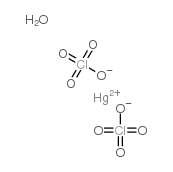73491-34-6
| Name | mercury(2+),diperchlorate,trihydrate |
|---|---|
| Synonyms |
Mercury diperchlorate trihydrate
MERCURY(II) PERCHLORATE TRIHYDRATE Perchloric acid,mercury(2+) salt,trihydrate (9CI) Mercuricperchlorate trihydrate |
| Density | 4 g/cm3 |
|---|---|
| Molecular Formula | Cl2H2HgO9 |
| Molecular Weight | 417.50600 |
| Exact Mass | 417.87800 |
| PSA | 157.77000 |
| LogP | 0.36180 |
|
Section 1: Product Identification Chemical Name:Mercury (II) perchlorate trihydrate, 99+% CAS Registry Number:73491-34-6 Formula:Hg(ClO4)2.3H2O EINECS Number:none Chemical Family:metal perchlorate salt Synonym:Perchloric acid, Mercury(II) salt, trihydrate.
Section 2: Composition and Information on Ingredients IngredientCAS NumberPercentACGIH (TWA)OSHA (PEL) Title Compound73491-34-6100%0.025mg/m31mg/10m3 Section 3: Hazards Identification Emergency Overview:Causes irritation to the eyes, skin and respiratory tract. May affect thyroid and kidney functions. Primary Routes of Exposure:Ingestion Eye Contact:Causes irritation of the eyes. Skin Contact:Causes irritation of the skin. Harmful in contact with skin. Inhalation:Effects include severe respiratory and gastrointestinal distress and damage the central nervous system. Toxic if swallowed. Ingestion may lead to dizziness, abdominal cramps, vomiting, bloody diarrhea, weakness Ingestion: and convulsions. Acute Health Affects:Poison. Severe immediate toxicity of the gastrointestinal tract that can be fatal The chronic effects of mercury poisoning include stomatitis, tremors, physic disturbances, excessive Chronic Health Affects:salivation, pain on chewing, loss of memory, irritability and depression. Perchlorates reversibly inhibit thyroid iodine uptake. Kidney function affected. NTP:No IARC:No OSHA:No SECTION 4: First Aid Measures Immediately flush the eyes with copious amounts of water for at least 10-15 minutes. A victim may need Eye Exposure: assistance in keeping their eye lids open. Get immediate medical attention. Wash the affected area with water. Remove contaminated clothes if necessary. Seek medical assistance if Skin Exposure: irritation persists. Remove the victim to fresh air. Closely monitor the victim for signs of respiratory problems, such as difficulty Inhalation: in breathing, coughing, wheezing, or pain. In such cases seek immediate medical assistance. Seek medical attention immediately. Keep the victim calm. Give the victim water (only if conscious). Induce Ingestion: vomiting only if directed by medical personnel. SECTION 5: Fire Fighting Measures Flash Point:no data Autoignition Temperature:no data Explosion Limits:no data Extinguishing Medium:Water spray Spray closed containers with water until fire is out. Avoid contact with combustible material. Fire fighters Special Fire Fighting Procedures: should be equipped with a NIOSH approved self-contained breathing apparatus. Hazardous Combustion andIf involved in a fire this material may emit corrosive hydrogen chloride fumes and toxic mercury vapors. Decomposion Products: Releases oxygen on heating. May decompose explosively under fire fighting conditions. Do not mix with Unusual Fire or Explosion Hazards: combustibles. SECTION 6: Accidental Release Measures Do not mix spilled powder with any combustible materials, such as sawdust. Sweep up the solid and dilute Spill and Leak Procedures: with water. SECTION 7: Handling and Storage Store in a tightly sealed container in a cool dry place away from combustible and flammable materials. If the Handling and Storage: container is left open, salt may adsorb moisture from the atmosphere SECTION 8: Exposure Controls and Personal Protection Eye Protection:Always wear approved safety glasses when handling a chemical substance in the laboratory. Skin Protection:Wear protective clothing and gloves. Ventilation:If possible, handle the material in an efficient fume hood. If ventilation is not available a respirator should be worn. The use of respirators requires a Respirator Respirator: Protection Program to be in compliance with 29 CFR 1910.134. Ventilation:If possible, handle the material in an efficient fume hood. Additional Protection:No additional protection required. SECTION 9: Physical and Chemical Properties Color and Form:white xtl. Molecular Weight:399.46 (453.51) Melting Point:no data Boiling Point:no data Vapor Pressure:no data Specific Gravity:~4 Odor:none Solubility in Water:soluble SECTION 10: Stability and Reactivity Stability:Hygroscopic Hazardous Polymerization:no hazardous polymerization Conditions to Avoid:Any contact with combustible matter. Incompatibility:Reducing agents, organic matter, active metals, phosphorus, sulfur, hydrazine, hydroxylamine, strong acids Decomposition Products:Oxygen, mercury oxide, hydrogen chloride, SECTION 11: Toxicological Information RTECS Data:No information available in the RTECS files. Carcinogenic Effects:No data available Mutagenic Effects:No data available Tetratogenic Effects:No data available SECTION 12: Ecological Information Avoid release to the environment. Very toxic to aquatic organisms. May cause long-term adverse effects in the Ecological Information: aquatic environment. SECTION 13: Disposal Considerations Disposal:Dispose of according to local, state and federal regulations. SECTION 14: Transportation Shipping Name (CFR):Oxidizing solid, Toxic, N.O.S. Hazard Class (CFR):5.1 Additional Hazard Class (CFR):6.1 Packaging Group (CFR):II UN ID Number (CFR):UN# 3087 Shipping Name (IATA):Oxidizing Solid, Toxic, N.O.S. Hazard Class (IATA):5.1 Additional Hazard Class (IATA):6.1 Packaging Group (IATA):II UN ID Number (IATA):UN# 3087 SECTION 15: Regulatory Information TSCA:Not listed in the TSCA inventory. SARA (Title 313):Title compound: See Category Code N458. Second Ingredient:none SECTION 16 - ADDITIONAL INFORMATION N/A |
| Hazard Codes | T+: Very toxic;N: Dangerous for the environment; |
|---|---|
| Risk Phrases | 8-33-36/37/38 |
| Safety Phrases | 17-26-27-36/37/39-45 |
| RIDADR | UN 3086 6.1/PG 2 |
